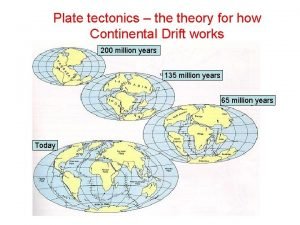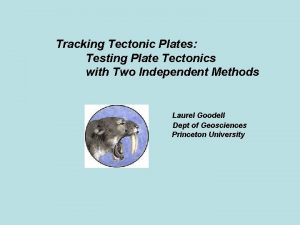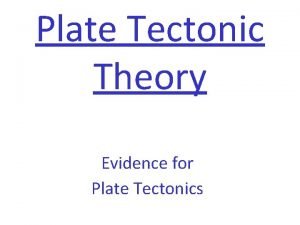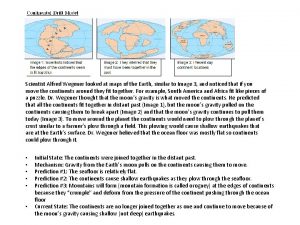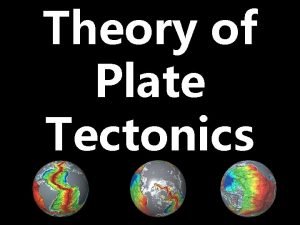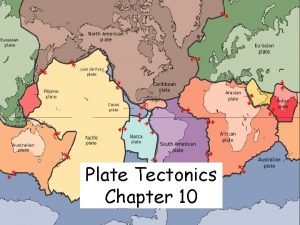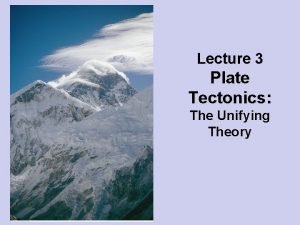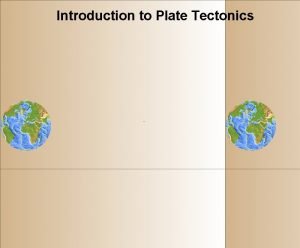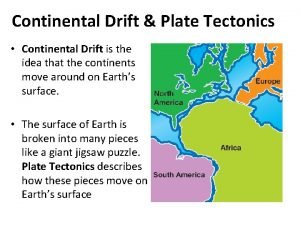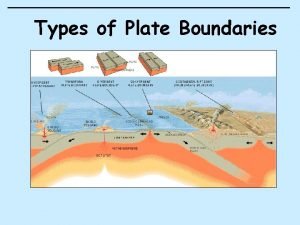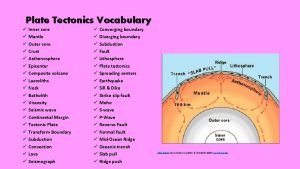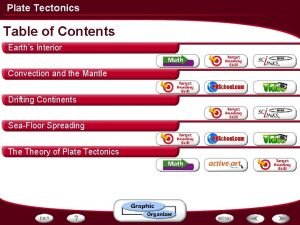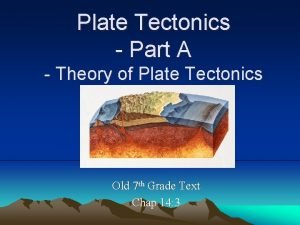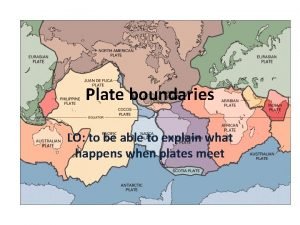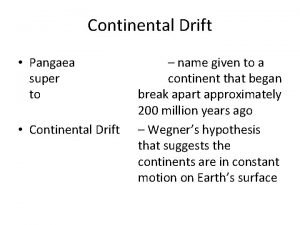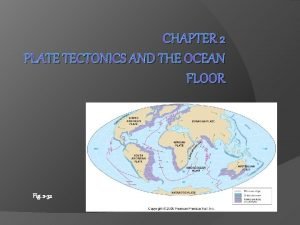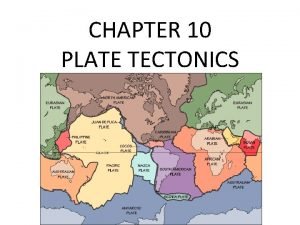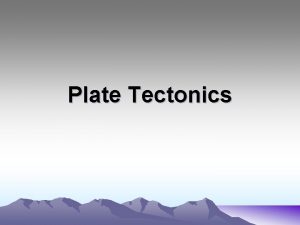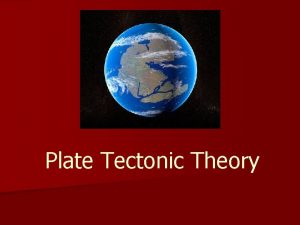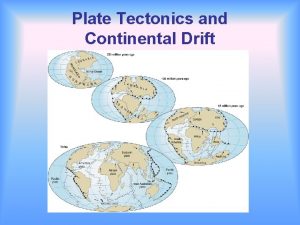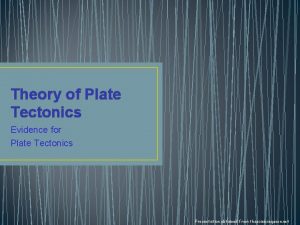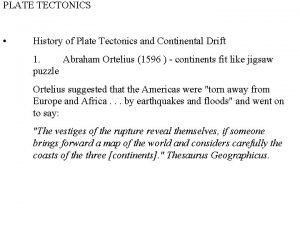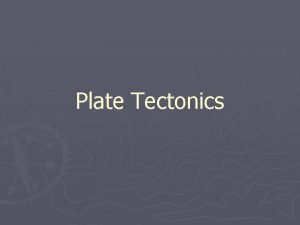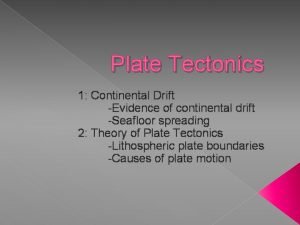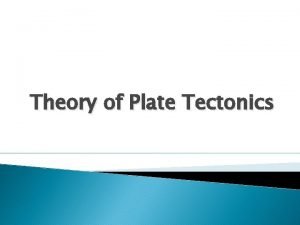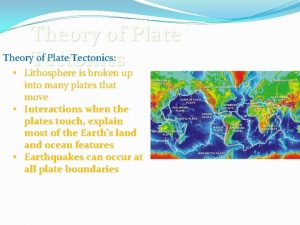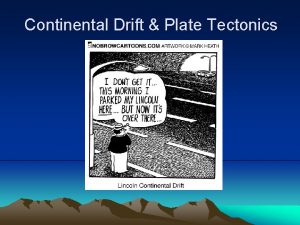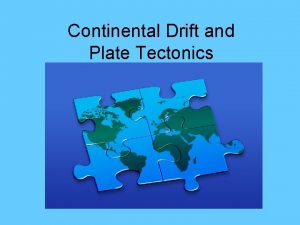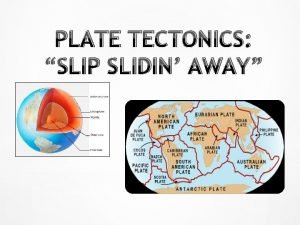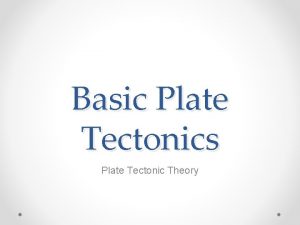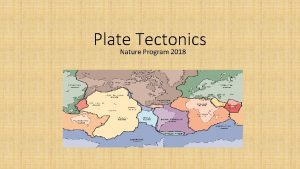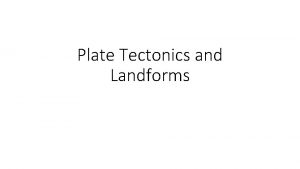Plate Tectonic Theory Evidence for Plate Tectonics CONTINENTAL





























- Slides: 29

Plate Tectonic Theory Evidence for Plate Tectonics

CONTINENTAL DRIFT • In the early 1900’s Alfred Wegener hypothesized that all continents were once joined together in a single land mass he called Pangea (Greek for “all land”). • He proposed that Pangea had split apart, and the continents had gradually moved to their present positions. This process became known as continental drift.

CONTINENTAL DRIFT According to the hypothesis of continental drift, continents slowly moved to their current locations.

This was Pangaea about 200 million years ago, before it began breaking up. Wegener named the southern portion of Pangaea Gondwana, and the northern portion Laurasia.

These were the continents about 70 million years ago. Notice that the breakup of Pangea formed the Atlantic Ocean. India later collided with Eurasia to form the Himalayan Mountains.

This is the position of the continents today. The continents are still slowly moving at about the speed your fingernails grow. Satellite measurements have confirmed that the Atlantic Ocean gets a few inches wider every year!

Wegener’s Evidence for Continental Drift The continents fit together like a puzzle…Ex: The Atlantic coastlines of Africa and South America. The best fit includes the continental shelves.

Wegener’s Evidence for Continental Drift Fossils of plants and animals of the same species can be found on different continents.

Wegener’s Evidence for Continental Drift • Wegener looked at the order of rock layers in South America, Africa, India, Antarctica, and Australia. • He found that each location showed remarkable similarities. • Wegener showed that the same three layers occur at each of these places.

Wegener’s Evidence for Continental Drift • Since these areas are now separated by oceans, Wegener proposed that the rock layers were made when all the continents were still a part of Pangaea.

Wegener’s critics • Scientists and other interested individuals agreed that Wegener’s evidence was compelling, but wondered why we could not feel the movement of the continents? • They also explained that there should be evidence to show that the continents were still moving today if Wegener’s hypothesis was correct.

• Wegener was a meteorologist, not a geologist, and because of the aforementioned questions his theory was not well accepted. • Wegener later died on an expedition in Greenland while collecting ice samples.

• The main reason scientists had a hard time accepting Wegener’s theory is that there seemed to be no mechanism for the motion of the continents. • In other words, the scientists could not explain what might cause the continents to move.

Seafloor Spreading • Then, in the 1960’s, a scientist named Henry Hess made a discovery that would vindicate Wegener. • Using new radar technology, Hess discovered that the seafloor has both trenches and mid-ocean ridges. • Hess then proposed theory of sea-floor spreading.

Seafloor Spreading • Hess proposed that there is hot material below the Earth’s crust that is less dense than the material around it. • He hypothesized that the hotter, less dense material rises toward the surface at the mid-ocean ridges and then flows sideways, pushing the seafloor away from the ridge in both directions. • This is process is known as ridge push.

Seafloor Spreading • As the seafloor spreads apart at a mid-ocean ridge, new seafloor is created. • The older seafloor moves away from the ridge in opposite directions. • The theory of seafloor spreading explained how the crust could move, whereas theory of continental drift had no explanation to offer.

Evidence for Spreading • In 1968, scientists aboard the research ship Glomar Challenger began gathering information about the rocks on the seafloor. • Scientists found that the youngest rocks are located at the mid-ocean ridges.

Mechanism for Plate Tectonics • Seafloor Spreading provided insight into the mechanism for how the continents moved. • The magma which pushes up at the mid-ocean ridge provides the new seafloor that pushes the plates, and then subduction zones gobble up the old land on the other side of the plates. • The mechanism for plate tectonics was convection currents inside Earth!

PLATE TECTONIC THEORY • Both Hess’s discovery and Wegner’s continental drift theory combined into what scientists now call theory of Plate Tectonics. • Theory of plate tectonics: • The Earth’s crust and part of the upper mantle are broken into sections, called plates, which move on a plastic -like layer of the mantle.

CONVECTION CURRENTS • Hot magma (molten rock) inside the Earth moves toward the surface, cools, then sinks again. • These convection currents beneath the plates cause the plates to move.


RIDGE PUSH • Ridge push is associated with oceanic/oceanic divergent boundaries. • Hot, less dense magma below Earth’s crust rises toward the surface at the mid-ocean ridges. • Then, it flows sideways, pushing the seafloor away from the ridge in both directions.

GRAVITY PULL • Gravity Pull is associated with convergent plate boundaries. • When the more dense plate subducts, it is pulled by gravity. • Denser, less buoyant plates ride lower on the asthenosphere due to their weight and the natural pull of gravity. • This helps allow the less dense, more buoyant plates to ride over the more dense plate.



1782 - Benjamin Franklin Pre-supposes the Theory of Plate Tectonics "Such changes in the superficial parts of the globe seemed to me unlikely to happen if the earth were solid to the centre. I therefore imagined that the internal parts might be a fluid more dense, and of a greater specific gravity, than any of the solids we are acquainted with; which therefore might swim in or upon that fluid. Thus the surface of the globe would be a shell, capable of being broken and disordered by the violent movements of the fluid on which it rested. . You see, I have given a loose to imagination; but I approve much more your method of philosophizing, which proceeds upon actual observations, makes a collection of facts, and concludes no farther than those facts will warrant. ” Benjamin Franklin: Letter of September 22, 1782 to the Abbe Soulavie: Quoted in: Van Doren, Carl, 1938, 1987 edition. “Benjamin Franklin, ” Published by Bramhall House, New York. p. 660.

QUESTIONS. . . • What processes cause plates to move? • What happens in a convection current?

Plate Tectonic Theory The theory of Plate Tectonics explains the cause of: –Earthquakes –Mountains –Volcanoes

 Continental drift vs plate tectonics theory
Continental drift vs plate tectonics theory Continental drift theory and plate tectonics theory
Continental drift theory and plate tectonics theory Continental drift
Continental drift Plate motion calculator
Plate motion calculator Plate tectonic theory evidence
Plate tectonic theory evidence Plate tectonics vs continental drift
Plate tectonics vs continental drift Compare continental drift and plate tectonics
Compare continental drift and plate tectonics The plate tectonics theory states that
The plate tectonics theory states that Summarize the theory of plate tectonics
Summarize the theory of plate tectonics Types of volcanoes
Types of volcanoes Unifying theory of plate tectonics
Unifying theory of plate tectonics Theory of plate tectonics
Theory of plate tectonics 7 lithospheric plates
7 lithospheric plates Oreo tectonic plates
Oreo tectonic plates Convergent boundary
Convergent boundary Convergent plate boundary
Convergent plate boundary What are four types of plate boundaries
What are four types of plate boundaries Webquest plate tectonics
Webquest plate tectonics Inner core vocabulary
Inner core vocabulary Seafloor spreading material at trenches
Seafloor spreading material at trenches Plate tectonics definition
Plate tectonics definition Driving force of plate tectonics
Driving force of plate tectonics What is this process called
What is this process called Harry hess and seafloor spreading
Harry hess and seafloor spreading Mantle magma
Mantle magma Constructive plate boundary
Constructive plate boundary Oreo tectonic plates
Oreo tectonic plates Pangaea
Pangaea From now
From now Fossils as evidence of continental drift
Fossils as evidence of continental drift


